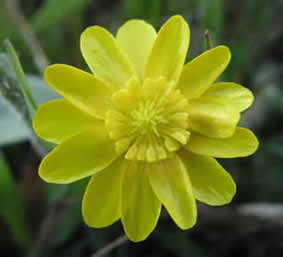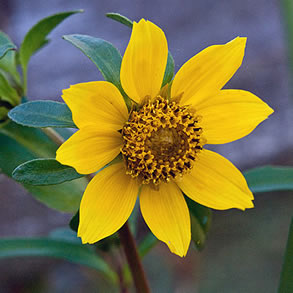AN INTRODUCTION TO VASCULAR PLANT IDENTIFICATION

California buttercup (Ranunculus californicus), photo by Matt Fairbarns.
There are many books and manuals available that you can use to learn how to identify the vascular plants of British Columbia and there are several other key resources available in BC for learning more about BC's wild plants. Use these links to get started and to find the tools that will help you to learn how to identify our wild plant species.
Using Flower Colour
Many people identify vascular plants by flower colour. Then they narrow down the identification by looking at all species with the flower colour they are interested in. Some field guides are organized by flower colour and present many common species in colour categories. This method can work for common 'wildflower' species.
Pattern, Pattern, Pattern: Identification Using Family Traits
The best way to approach plant identification, though, is to learn the 'pattern' that groups of plants express, starting with plant families. Groups of species in a family share common traits, and the combinations of these can be used to identify the family that a plant belongs to and, ultimately, the species. These traits, or key characters, are what botanists use in developing taxonomic keys for plant identification. The keys help sort features and ultimately lead you to a species identification. Once you know the family 'pattern', you will be able to recognize a 'daisy', a 'rose, a 'buttercup', or a 'maple'. The sorts of features that families of plants share include flower shape, number of stamens, number of petals, position of leaves, and types of roots.
If you go to our family name search page, you can view a list of the families of plants found in BC.
Once You Know the Family, then...
Once you know the family that your plant is in, then you can either use identification keys for that family to work out which genus and species you have, or you can browse through family groupings in field guides (see for example Pojar and MacKinnon's Plants of Coastal British Columbia) or, if you work with E-Flora BC, you can browse through all of the atlas pages for a given family.
For example, if you know your plant is a 'grass', then browse through the E-Flora listings for grass species by calling up the grass family--the Poaceae--in the family name search. If the plant is grass-like, it might not be a grass, but could be a sedge. In this case, call up the sedge family--the Cyperaceae. If you know your plant looks like a daisy type of flower, then call up the daisy family--the Asteraceae. Sometimes you can guess the type of plant you are viewing because it looks like a more familiar garden plant. Find out the family that the garden plant belongs to, then browse that family.
How to Learn Plant Families
Learning plant families means learning about plant parts and the terminology used for these. Some of these terms seem daunting at first but once you know them then plant identification is simplified. This includes learning about the number of stamens a plant typically has, how many petals are typical, the position of the ovary in the flower, the presence/absence and shape of stipules at the base of leaves, the positioning of leaves (opposite or alternate) and more.
Learning plant families is the best way to learn the plants of British Columbia.

Nodding beggarticks (Bidens cernua), photo by Real Sarrazin. Species of Bidens have daisy-like flowers that are typical of members of the Daisy Family (Asteraceae)
A Few Common Plant Families
Recognition characters are provided below for a few plant famiilies found in BC. These are excerpted from Vascular Plant Families (by James Payne Smith Jr., 1977).
Rosaceae (Rose Family)
Stipulate herbs, shrubs and trees with 5-merous (petals in multiples of 5) flowers, a hypanthium, and many stamens.
Fabaceae (Pea Family)
Herbs, shrubs, vines, and trees with alternate, stipulate, compound leaves. Flowers are actinomorphic or zygomorphic, 5-merous, unicarpellate; fruit ia a legume or loment.
Ericaceae (Heath Family)
Woody plants, usually shrubs, with leathery, often evergreen leaves, urceolate or campanulate flowers with anthers opening by terminal pores.
Convolvulaceae (Morning Glory Family)
[In BC,] trailing vines, often with milky latex, 5-merous flowers with a tubular, plaited corolla, 5 eipietalous stamens and a bicarpellate gynoecium.
Polygonaceae (Knotweed Family)
Herbs with swollen nodes, ocreae or involucrate heads, petaloid calyx, and a lens-shapded or triangular achene, often black.
Primulaceae (Primrose Family)
Herbs with opposite basal, or whorled leaves, 5-merous flowers, stamens opposite the petals, and free-central placentation.
Salicaceae (Willow Family)
Catkin-bearing dioecious (male and femlae parts in separate flowers/plants) trees and shrubs with comose seeds.
Violaceae (Violet Family)
Herbs [in BC] with 5-merous, zygomorphic (having petals of two or more different shapes and sizes) corolla, 3 carpellate gynoecium, spurred flower, spurred anthers and an explosive capsule.
Macoun's Poppy (Papaver lapponicum) has the characteristic papery look that species in the Poppy Family (Papaveraceae) share. Photo by Ian Cumming.
Plant Characters or Traits
We have outlined below some of the common questions to start with when identifying a plant species:
As you work through the identification of your plant, there are a few others things to consider in narrowing down the species identification:
1. Does the BC distribution fit?
Check the distribution map on the E-Flora atlas page to be sure the species you have identified is actually found in your region. For example, some species are very restricted in their range in BC and may only be found in the dry interior, in the Fraser Delta, or along the coast of the province. Even a kilometer can make a difference when it comes to species distributions. Very similar-looking species can often be sorted out by looking at their distribution. Use region of occurrence to vet possible identifications.
2. Is the habitat correct?
Check the habitat information for the species on the E-Flora atlas page. Habitat is an important aid in plant identification. For example, if your plant was found on a dry sand dune, then it is unlikely to be a species that only occurs in wet cattail marshes or rocky outcrops. This is true even if you have the region of occurrence correct. With fungi this can be even more specific because fungi species are often found only on certain host trees or substrates. If your fungus was found growing on the trunk of an evergreen tree then it won't be a species that is found growing only on birch trees. Pay attention to habitat and host to help narrow the possibilities.
3. Is the elevation correct?
Often there are similar looking species that are found at other elevations, and species are often specific in their preferences for high elevation versus low elevation. It helps to be aware of the elevation where your plant is found.
4. Are there any similar species that could cause confusion?
Once you have used an identification guide or technical manual to come up with a name, use E-Flora to see if there are any similar species that could be confused with your species. Become familiar with flowers of similar colour or similar shape, and learn to separate these based on other traits such as leaf shape or habitat preferences. While field guides cover species such as buttercups, wild roses, and lupines, they only provide information on a handful of species. For example, a local field guide might list five species of buttercups, but it is helpful to know that there are actually 40 species of buttercups in BC.

Red-osier dogwood (Cornus stolonifera)--dogwoods all share common vennation patterns on the leaves, and leaves are opposite. Photo by Brian Klinkenberg.
Last Thoughts...
1) If you find something similar looking to your plant in a field guide or on E-Flora BC, pay attention to its broader distribution in North America. If the plant is primarily an eastern species, or a desert species, or an Arctic species, is it likely that this is what you have found?
2) Don't forget to use your senses. Does your plant have an aroma or odor? Do the leaves smell minty, or pungent? Does the plant feel velvety, or smooth to the touch? Does it sting when you touch it? It pays to learn stinging nettle and poison ivy right away, and avoid these plants!
3) When thinking about morphology, look closely. Some things might look similar at first glance, but are often actually variable when you take a closer look. For example, roses are generally 'thorny', but specialists separate 'thorns' into thorns and prickles and spines, and some roses have none of these. Which type of 'thorn' does your plant have?
4) When considering the size of your plant, also look at its form or habit. Is it an erect plant? Or does it sprawl on the ground? Is it a vine that trails on the ground. Is it bushy? These growth 'habits' are important features in species identification.
5) Is your plant really wild? If you can't find your plant in a wildflower guide, it may be that it is a garden species that has not naturalized in BC. Check a garden guide for identification.
It may be that after looking closely at your plant, working through plant keys, and checking photos and illustrations in E-Flora BC and in field guides, you still can't name your plant with certainty. This is when it helps to ask an expert.
Recommended citation: Author, date, page title. In: Klinkenberg, Brian. (Editor) 2023. E-Flora BC: Electronic Atlas of the Flora of British Columbia [eflora.bc.ca]. Lab for Advanced Spatial Analysis, Department of Geography, University of British Columbia, Vancouver. [Date Accessed]
E-Flora BC: An initiative of the Spatial Data Lab, Department of Geography UBC, and the UBC Herbarium.
© Copyright 2023 E-Flora BC.